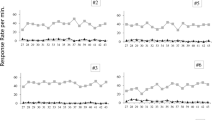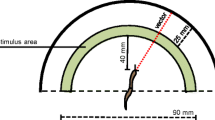Abstract
Rabbits were classically conditioned under a single-CS dual-ISI paradigm. Contrary to a previous experiment by Frey (1970), a separate CR was conditioned at each interstimulus interval (ISI), producing a double response (DR) on long-ISI trials. Further experiments indicated that DR development is facilitated by (a) circumorbital US-location and (b) relatively high US-intensity. However, subsequent shifts to nonoptimal conditions did not produce substantial decreases in DR frequency. The presence of DRs appears to be readily amenable to interpretation in terms of a Pavlovian stimulus-trace mechanism in which the US becomes associated with a particular temporal portion of the CS. An instrumental-response-shaping hypothesis of classical conditioning can explain these data only if the hypothetical reinforcement mechanism is assumed to be considerably more complex than had previously been supposed.
Similar content being viewed by others
References
Frey, P. W.: Within-subject analysis of the CS-US interval in rabbit eyelid conditioning.Learning and Motivation,1:337–345, 1970.
Cormezano, I.: Classical conditioning.In J. H. Sidowski (Ed.):Experimental Methods and Instrumentation in Psychology, New York, McCraw-Hill, 1966.
Hoehler, F. K. and Leonard, D. W.: Classical nictitating membrane conditioning in the rabbit(Oryctolagus cunniculus): Single alternation with differential intertriai intervals.J. Comp. Physiol. Psychol.,85:277–288, 1973.
Leonard, D. W. and Theios, J.: Effect of CS-US interval shift on classical conditioning of the nictitating membrane in the rabbit.J. Comp. Physiol. Psychol.,63:355–358, 1967.
Martin, I. and Levey, A. B.:The Genesis of the Classical Conditioned Response. London, Pergamon Press, 1969.
Melzack, R. and Wall, P. D.: Pain mechanisms: A new theory.Science,150:971–979, 1965.
Pavlov, I. P.:Conditioned Reflexes. (Translated by G. V. Anrep). London, Oxford University Press, 1927.
Prokasy, W. F.: Classical eyelid conditioning: Experimenter operations, task demands and response shaping.In W. F. Prokasy (Ed.):Classical Conditioning. New York, Appleton-Century-Crofts, 1965.
Author information
Authors and Affiliations
Additional information
This Research was supported in part by United States Public Health Service Grant No. MH 22514-01 to the second author.
Rights and permissions
About this article
Cite this article
Hoehler, F.K., Leonard, D.W. Double responding in classical nictitating membrane conditioning with single-CS dual-ISI training. Pav. J. Biol. Sci. 11, 180–190 (1976). https://doi.org/10.1007/BF03000295
Issue Date:
DOI: https://doi.org/10.1007/BF03000295




